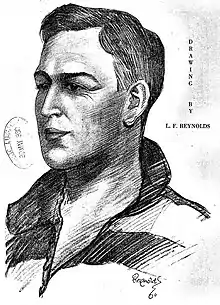Carji Greeves
Edward Goderich "Carji" Greeves Jr. (1 November 1903 – 15 April 1963) was an Australian rules footballer who played for the Geelong Football Club in the Victorian Football League (VFL), now known as the Australian Football League (AFL). He won the inaugural Brownlow Medal in 1924, awarded to the VFL/AFL player adjudged fairest and best during the home-and-away season. He is the son of Ted Greeves, who also played with the Geelong Football Club.
| Carji Greeves | |||
|---|---|---|---|
 Carji Greeves | |||
| Personal information | |||
| Full name | Edward Goderich Greeves, Junior | ||
| Nickname(s) | Carji | ||
| Date of birth | 1 November 1903 | ||
| Place of birth | Warragul, Victoria, Australia | ||
| Date of death | 15 April 1963 (aged 59) | ||
| Place of death | Ararat, Victoria, Australia | ||
| Original team(s) | Berrybank, Geelong College | ||
| Height | 175 cm (5 ft 9 in) | ||
| Weight | 76 kg (168 lb) | ||
| Position(s) | Midfield | ||
| Playing career1 | |||
| Years | Club | Games (Goals) | |
| 1923–33 | Geelong | 124 (17) | |
|
1 Playing statistics correct to the end of 1933. | |||
| Career highlights | |||
| |||
| Sources: AFL Tables, AustralianFootball.com | |||
Greeves is the namesake of the Carji Greeves Medal, the Geelong Football Club's best and fairest award.
Family and personal life
In the 1860s, Greeves' grandmother Julie (née Anderson) was briefly engaged to Tom Wills, the famed cricketer and founder of Australian rules football. Historian Col Hutchinson noted that "If Tom Wills had married Julie, we wouldn't have had Carji Greeves".[1]
Greeves was given the nickname "Carji" as a baby by a friend of the family, the New South Wales golfer Michael Scott,[2] most likely after a character in A Country Girl, a popular musical play of the day.[3]
Greeves also attended The Geelong College after receiving his early education at the Struan Dam School, South of Lismore, Victoria, where he was a schoolmate of Geelong champion Reg Hickey.
VFL career

Greeves played with the Geelong Football Club from 1923 to 1931 and wore jumper number 20.
Greeves was honoured with having the Geelong Football Club's best-and-fairest award named after him, the Carji Greeves Medal. In 1996, Greeves was inducted into the Australian Football Hall of Fame. He also won the first Brownlow Medal, the award given to the player deemed to be the "fairest and best." "Best" refers to the players being voted upon by officials for who was best on ground, and "fairest" means that the player did not serve a suspension during the competition.
Greeves represented Victoria in interstate matches seven times.
Post Football
Greeves kicking prowess had him head hunted by college football club UCLA in 1928 as a kicking coach and he moved to the United States.[4] He would study at Stanford University, where he coached students there in Australian Rules.[5]
From the 1930s, Greeves suffered from pulmonary tuberculosis and emphysema. He died on 15 April 1963 at the age of 59.[6]
Since 2004, The 'Carji' Greeves Club is the name of the Football Parents' Support Club at The Geelong College.[7]
References
- Critchley, Cheryl (12 June 2013). "The mad catter" Archived 13 December 2013 at the Wayback Machine, The Weekly Review. Retrieved 11 December 2013.
- Ross, John (1999). The Australian Football Hall of Fame. Australia: HarperCollinsPublishers. p. 71. ISBN 0-7322-6426-X.
- "Greeves, Edward Goderich (Carji) (1903–1963)". Australian Dictionary of Biography. National Centre of Biography, Australian National University.
- "Teams for America". Sporting Globe. No. 1014. Victoria, Australia. 27 April 1932. p. 8 (Edition2). Retrieved 30 September 2021 – via National Library of Australia.
- "Our Game in America". The Herald. No. 15, 996. Victoria, Australia. 24 August 1928. p. 15. Retrieved 6 October 2021 – via National Library of Australia.
- Austin, A. G., "Greeves, Edward Goderich (Carji) (1903–1963)", Australian Dictionary of Biography, Canberra: National Centre of Biography, Australian National University, retrieved 27 September 2021
- "CARJI GREEVES CLUB – Heritage Guide to The Geelong College". gnet.geelongcollege.vic.edu.au. Retrieved 27 September 2021.